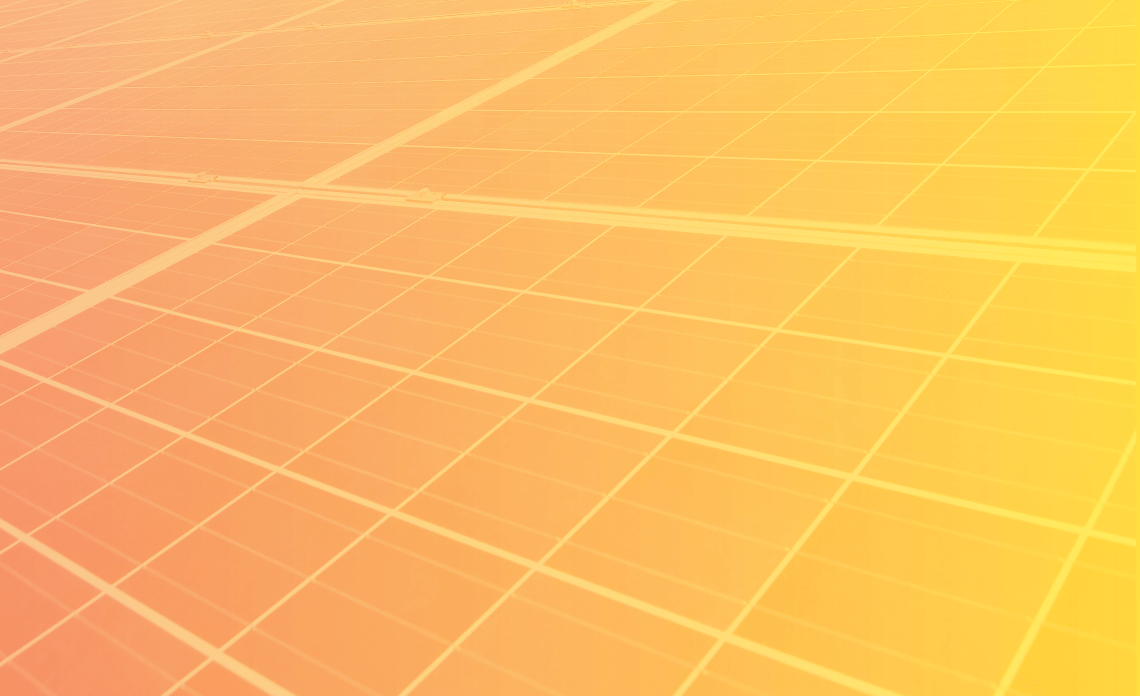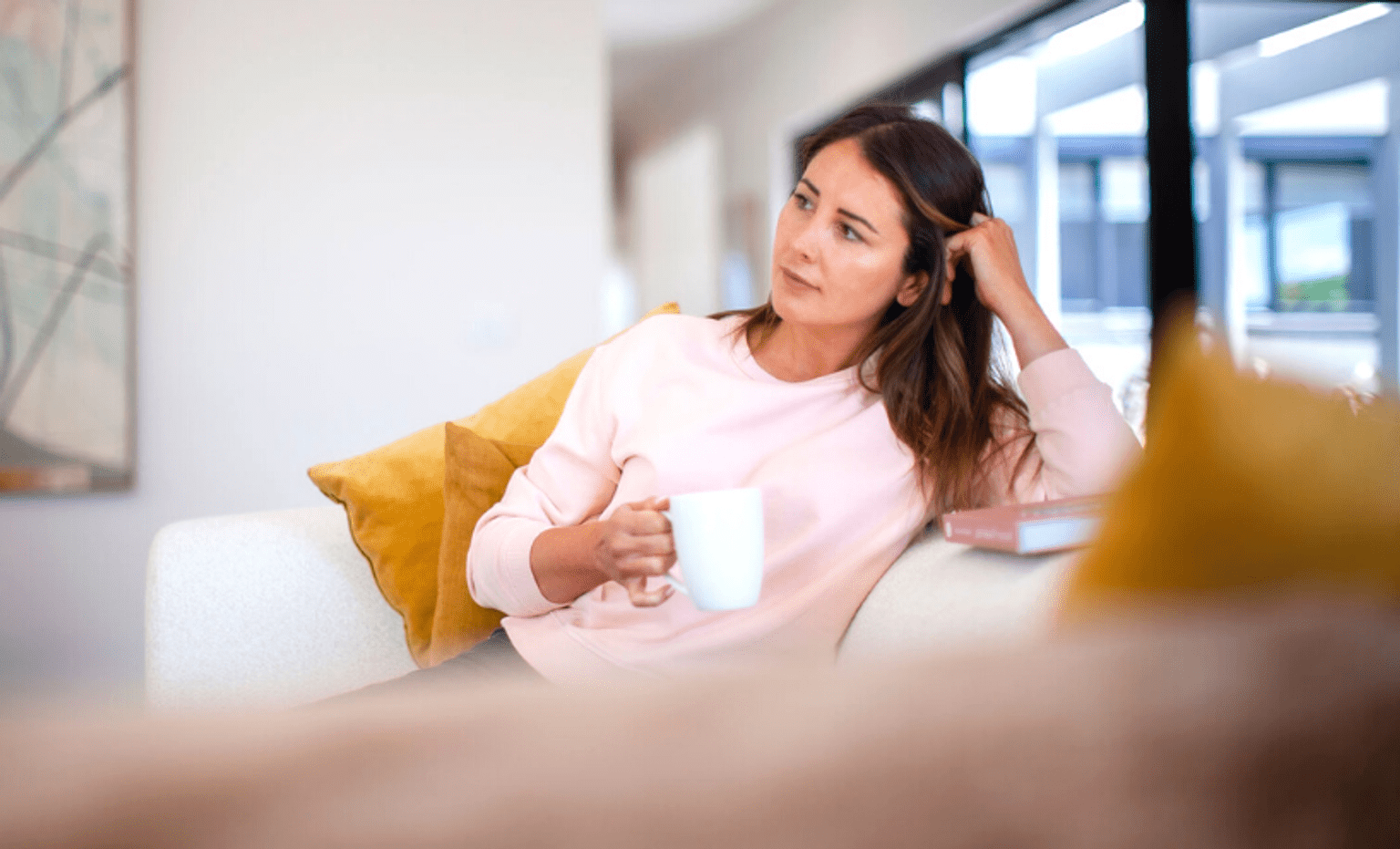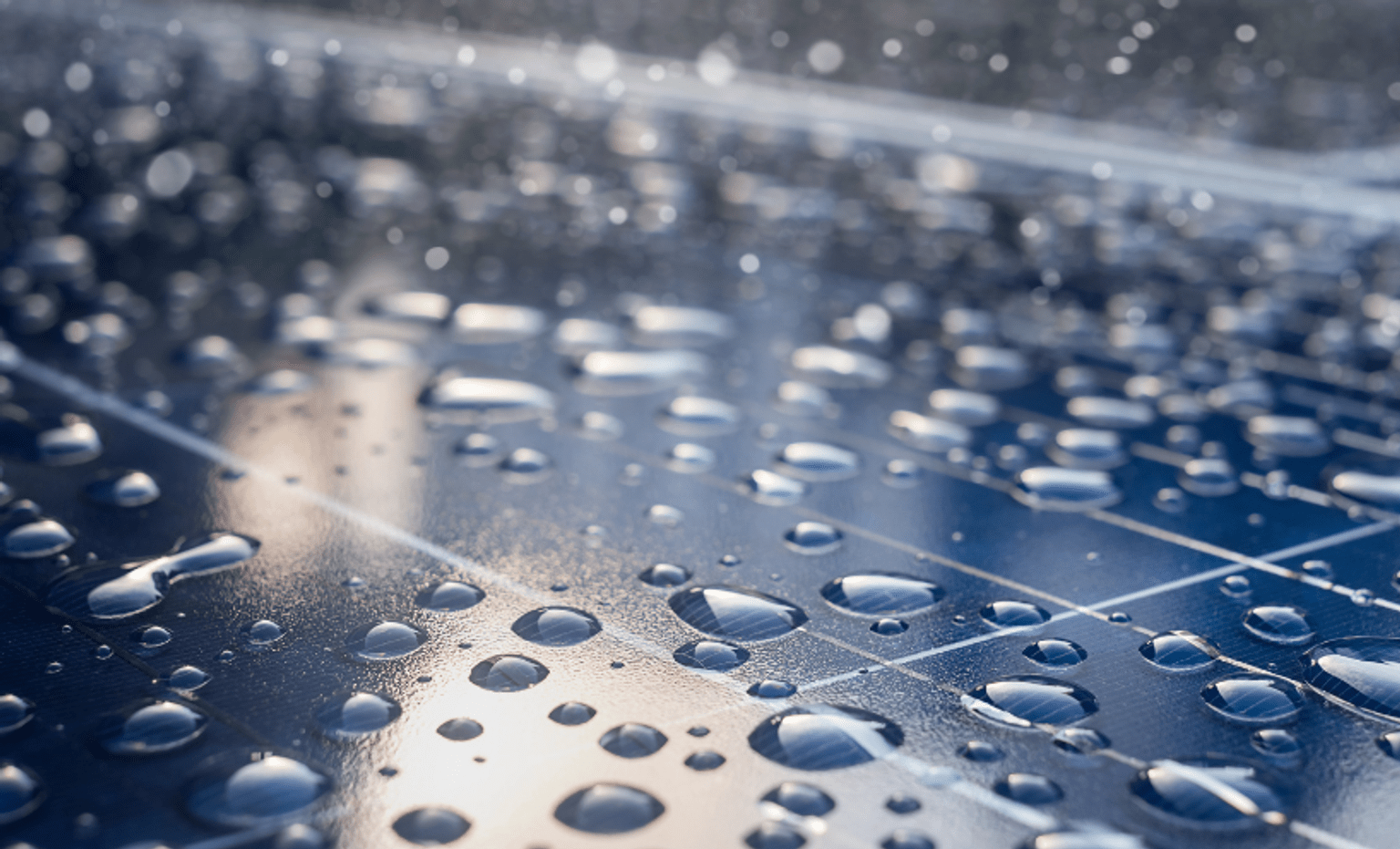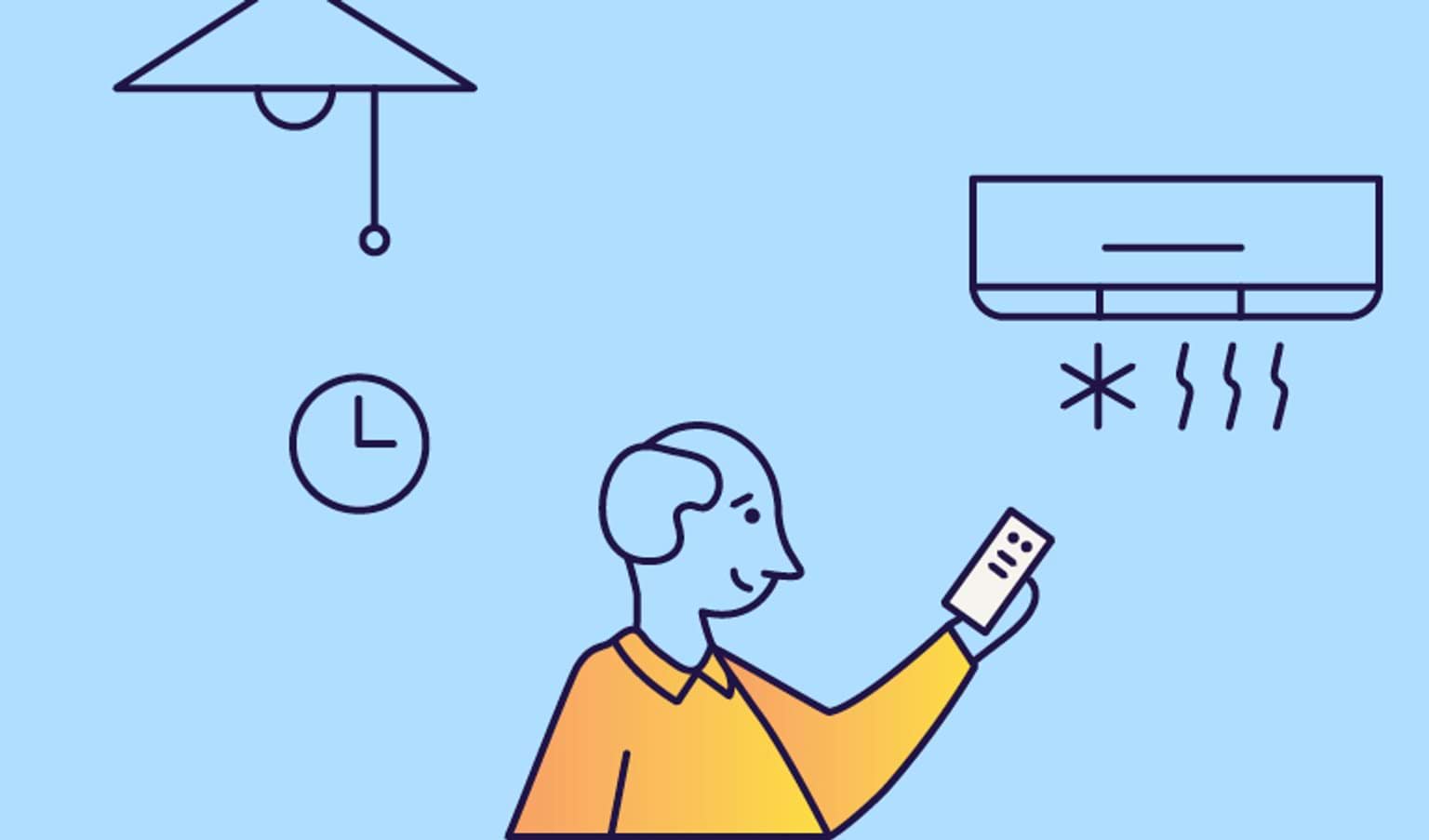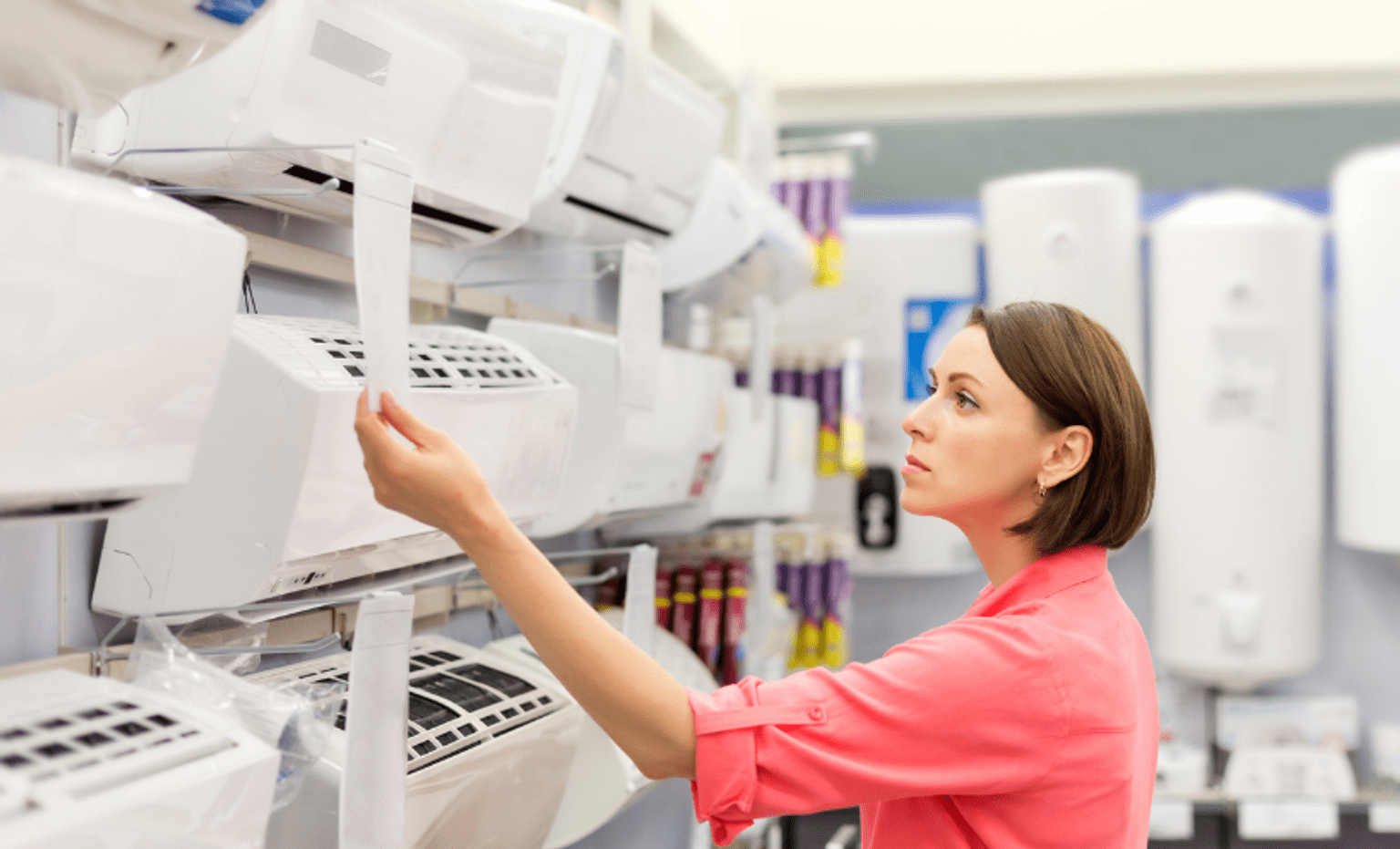- Date:
- 14 July 2021
Introduction
Whether you are a property owner, renter or rental provider, upgrading from an inefficient heater in your property can provide greater thermal comfort, that is, being more comfortable with the temperature indoors, which in turn brings social, health and wellbeing benefits. An energy-efficient reverse-cycle air conditioner can provide heating and cooling for your home in one appliance, for year-round comfort.
To get the most out of a system it needs to be planned and installed properly. This guide explains factors to consider that will help you choose a well-designed system that will heat and cool your home in the most efficient way possible.
More efficient heating and cooling means that you can become more comfortable in your home while using less energy for the same benefit. A more modern, efficient reverse-cycle air conditioner also provides better environmental outcomes with fewer emissions than outdated systems.
Victoria’s climate means that we experience significant cold in winters and that heating is an important aspect of our homes. A warmer home can improve the experience of some health conditions. Heating our homes is the highest user of energy for most of us and costs us the most.
Staying cooler at home in hot weather can help you sleep better at night and be more comfortable during the day. Health conditions can be exacerbated by a sensitivity to heat while extreme heat can be dangerous to many.
This guide includes information, to help you plan the right system for your home. It will support you to learn about reverse-cycle air conditioners and the factors that you should consider before purchasing and using your system.
What is Thermal Comfort? The word thermal relates to heat or temperature, and so thermal comfort is simply a way of describing whether you feel too hot, or too cold in a space. Better heating and cooling in your home, can help to improve your level of thermal comfort.
Getting started
Read this guide to help you decide whether a reverse-cycle air conditioner will be the right choice for your home and learn what factors will influence a purchase of the best unit for your circumstances. Read through each section and visit our website to learn more about efficient heating and cooling.
The first step is knowing what size system to buy, and this guide explains how a Supplier will recommend the right size system for your home.
When shopping around for the recommended size system, consider the other factors explained in this document, like purchase cost, running costs and how much you will end up using the system.
We recommend that you do your own research into reverse-cycle air conditioner models, talk to friends and family with similar systems and seek independent advice.
You will also see references to other resources who can help your research, including CHOICE, and Sustainability Victoria, who have both supported the development of this guide.
What to consider before buying a system
- Learn about reverse-cycle air conditioners
- Find out what size system suits your household
- Consider the costs and affordability of a new system
- Learn how to run a reverse-cycle air conditioner efficiently
- Learn more about energy efficiency benefits
- Find an approved product
- Contact an approved supplier
Section 1: About reverse-cycle air conditioners
Reverse-cycle air conditioners, sometimes known as split systems, or split system air conditioners, are one of the most common air-conditioner types in Australia.
Reverse-cycle air conditioners, sometimes known as split systems, or split system air conditioners, are one of the most common air-conditioner types in Australia. They use heat pump technology to extract heat from the outside air and transfer it to an indoor unit with a heat exchanger and fan to blow the heated air into the room.
As these units don’t produce warm or cool air operating themselves, they are the most efficient form of electric heating. Each unit of electricity can generate up to 6 units of heat (in comparison to other electric heaters which can never produce more than one unit of heat per unit of electricity.)
In air conditioner mode, the unit runs in the reverse – extracting warm air from the indoors and exchanging it with cooler air from outside, to cool the room.
Even if you already have a reverse-cycle air conditioner, you may be better off with an upgrade to a more current model as advancements in technology improve energy efficiency. This means that a newer more efficient appliance can heat more space for less output – which has an impact on the running cost as well as reduced emissions. A system that is more than 15 years old for example will typically use more than three times the amount of energy than a modern reverse-cycle air conditioner.
System size
Reverse-cycle air conditioners come in a range of heating and cooling capacities, or power outputs, which is often referred to as the ‘size’ of the system.
To maximise energy efficiency, it’s important that a unit is the right size for the room or area that it will be heating and cooling.
Suppliers will assess the room where the system will be installed and recommend the right system size, which will help ensure the system will run efficiently and not using too much energy. There is more information in this guide about how they will calculate the right size. When you are shopping around, this size is listed as a feature, and will be listed as a number in kilowatts, for example 3.5 kW.
Other features
Reverse-cycle air conditioners are not portable, and cost more than a portable space heater, though they serve a dual purpose of heating and cooling in the one appliance. They can heat or cool a room quickly. To function at their best for as long as possible, they should be regularly cleaned and serviced according to the manufacturers’ manual.
Reverse-cycle air conditioners can be powered by solar energy during the day if the home has solar PV panels.
Section 2: What to consider when choosing the right energy-efficient reverse-cycle air conditioner system for your home
Living with efficient and effective heating can bring health, wellbeing and social benefits and help you to feel more comfortable in your home year-round, so it is important to understand how to choose a suitable system for you.
Average cost of a new system
Like any product, the cost of reverse-cycle air conditioners can vary widely, but it is important to remember that the highest price doesn’t mean that it will be the best choice for you.
It is worth shopping around and looking out for seasonal discounts as the weather changes and in between peak seasons.
Product Affordability
As a guide only, the average cost of an installed 3.5 kW reverse-cycle air conditioner unit that might be suited for a modest sized living room is around $1,700. Of course, this will depend on the type of system – so we encourage you to shop around. It is important to think about this out-of-pocket cost when making your choice.
Factors affecting your reverse-cycle air conditioner running costs
It is likely that an energy-efficient reverse-cycle air conditioner can provide you with the best efficiency for your energy consumption per dollar – especially those with higher energy efficiency ratings.
However, air conditioner running costs depend partly on how much you use it. Likewise, any savings will depend on what heating and cooling you had previously and how much you used it.
For example, when you start using air conditioning in a home that hasn’t had installed air conditioning before, that may result in additional costs.
A home in a warmer climate, like Mildura, will probably have a need for more cooling, and a home in a cooler inland climate like Ballarat will have greater heating needs.
In addition to selecting a high efficiency rated model, installing the right system size for the space that it will be used in will maximise the efficiency, and minimise the running costs. A model with a higher efficiency rating can have lower running costs then a model with a lower efficiency rating in the same sized room.
Running costs are also affected by other factors such as the type of building materials, and whether the room is insulated well, or if the room has draughts to let warm air in or out. These factors are explained further in Section 3: Energy efficiency and getting the most out of your system.
To help you get an idea of what the running costs might be, Sustainability Victoria has calculated estimated average annual running costs for heating and cooling for different room sizes in Melbourne’s climate.
Ways to reduce running costs
In Victoria on average, about 50 per cent of home energy costs go to heating, so the way that you use heating and cooling appliances, as well as how much you use them, contribute to the running costs.
There are ways to use appliances more efficiently, so that you are getting the most out of your system whenever you use it. This means that the more energy-efficient way that you use your system, the more savings you will see over the course of the appliances lifetime.
Try this Household energy action guide from Sustainability Victoria, to get an idea of where you can save energy use with heating and cooling, and in other ways in your home. There is more information in this guide in Section 3: Energy efficiency and getting the most out of your system.
To help reduce your running costs, you can always check for new retail energy offers that suits you better than your current deal and will allow you to get better value from your energy.
The Victorian Energy Compare website can compare energy plans for you.
Why room size is important
Room size is one of the most important factors to consider for heating and cooling.
Installing a system that is too large or small for your space can cause other inefficiencies such as:
- Models too powerful for the room size may run frequent short cycles to achieve the target temperature. This can result in the room getting too cold or hot, inadequate dehumidification (i.e. not drying the air enough, making the room feel less comfortable), increased power consumption and running costs, and wear and tear on the system.
- Underpowered models may have to run more often at maximum output, which could dry the air too much and create excessive wear.
This table from CHOICE provides a rough guide for the system size for different rooms sizes, but you should take advice from the approved Supplier when they assess your home.
| Room size | Capacity |
|---|---|
| Up to 20 m2 | 2–2.5kW |
| 20–40 m2 | 2.5–5kW |
| 40–60 m2 | 4–6kW |
| 60–80 m2 | 5–7kW |
| 80+ m2 | 6–9kW |
Location and climate
The amount of energy you need to heat and cool your house depends on the climate at your location. Mildura is significantly warmer in summer so it will need more cooling than other Victorian climates. Ballarat and Alpine areas are much cooler in winter so they will need more heating than other Victorian climates. Inland climates also have a greater daily range of temperatures than coastal climates. For example, coastal Warrnambool and inland Ballarat will have different temperature ranges, because there is less cloud cover in inland climates, and this means that the climate cools down more overnight and heats up more during the day.
In high density residences, such as apartment complexes you may need to consider the impact of noise from reverse-cycle air conditioners on other residents. If you are planning on installing your new system in an apartment, you should contact the owner’s corporation. Owners Corporations are responsible for authorising the location of the air conditioner and any additional requirements or considerations, for installations on common property.
The Environmental Protection Agency also administers legislation and guidance regarding noise from home occupation, including noise from heating and cooling systems. The Regulation 114 of the Environment Protection Regulations 2021 prescribes items and lists times during which noise from such prescribed items is prohibited from impacting noise sensitives areas (such as neighbouring dwellings).
Section 3: Energy efficiency and getting the most out of your system
Not only should you buy the right size system for your home, but the way you use and maintain it will also help you get the most benefit from a new reverse-cycle air conditioner. These are some of the factors that can influence the efficiency of your heating and cooling.
Setting the temperature for different weather
To heat a room, try setting the temperature between 18°C to 20°C. Every 1°C higher will add around 10% to your heating bill.
Set your air conditioner thermostat for cooling between 24°C and 26°C for living areas – every degree lower in summer will increase running costs by around 10%.
Avoid heating or cooling empty rooms
In general, it is inefficient to heat or cool rooms if no one is using the room. Some systems have movement sensors that reduces the power when no one is in the room, so this could be a handy feature to look for when shopping around. If not, it might be best to turn the reverse-cycle air conditioner off when you are not home.
If your appliance has a programmable timer, you could set it to turn on or off automatically, so that your space is already warmed or cooled when you arrive home. This could be especially beneficial for homes with solar panels when the unit is powered by solar during the day while the energy is being generated.
It is cheaper to turn the cooling or heating off or down overnight while sleeping, and on again when you get up, or to set a timer to start warming or cooling just before you get up. A ceiling or pedestal fan could keep you comfortable during warmer nights and cost less to run but this will depend on the efficiency of the fan.
Some reverse-cycle air conditioners have an economy setting, or a ‘fan only’ mode which reduces energy use by maintaining moderate rather than cold temperatures and could cost less to run than air conditioning mode.
Doors and windows
In summer, take advantage of temperature drops in the evening and where practicable, open windows to bring cool breezes indoors
If you can, close off doors to the room where your reverse-cycle air conditioner is located to keep the heat (or cooled air) contained.
When heating a room, closing curtains or blinds will reduce heat escaping the home. Likewise, external shades on windows can reduce the heat entering your home in the first place.
Draughts and gaps under doors or windows will also allow air to leak from the room or allow outside temperatures which will reduce the performance or the unit.
System maintenance
Regular maintenance and cleaning of filters will ensure that your unit continues to work well for longer.
Check the manufacturer’s instructions or manual and have the air conditioner serviced regularly at the recommended frequency to ensure it continues to operate efficiently.
Cleaning the filters regularly helps the system operate effectively. Aim to clean the dust filters inside the plastic cover about twice a year, or more often if you use the unit very regularly. The filters should be easily removeable so that you can take them outdoors for a good shake or brush or check the unit’s manual for instructions.
This article from CHOICE is a good guide for how to clean your air conditioner.
Other ways to increase the energy efficiency of your home
Insulation
Insulation is another cost-effective way to improve the energy efficiency and comfort of your home. A fully insulated home compared to a non-insulated home can reduce the cost of heating and cooling a home by around 40 to 50 per cent. Adding bulk insulation, creates a more comfortable home year-round, virtually eliminates condensation on walls and ceilings and can pay for itself in around five to six years. Read more information about how insulation is important for energy efficiency in the home.
Draught proofing
Sealing gaps around walls, windows and floors will help keep the air temperature in your home more stable and prevent the heat escaping when you are heating. Draught proofing is finding and fixing draughts to make your home more comfortable and energy-efficient.
Draughts are similar to ventilation, in that both let fresh air into your home. Good ventilation can help reduce condensation and damp and can help cool down a hot house. Gaps on the other hand, are uncontrolled – they let too much cold air in and waste too much heat.
Self-adhesive draught seal tape, draught arrestors or draught snakes are an inexpensive way to draught proof your external doors. Seal small cracks and gaps with a caulking gun, and larger gaps with expanding foam.
Section 4: Finding an Approved Supplier and an approved product
Customers had to engage with an Approved Supplier from the Approved Suppliers list, and choose a product from the approved products list.
The Home Heating and Cooling Upgrades program is no longer accepting applications.
Approved products list
To ensure a range of high efficiency products are installed in Victorian households through the program, eligible reverse-cycle air conditioners are in the approved product list. All eligible products under the Home Heating and Cooling Upgrade Program must be rated at or above the equivalent of 4 Stars for efficiency under the Zoned Energy Rating Label. You will have to choose a product from this list to receive the Home Heating and Cooling Upgrade rebate. While the list will be updated throughout the duration of the program as more models qualify, the product must be on the list at the time of your purchase to be eligible for the rebate.
Product energy ratings
The Zoned Energy Rating Label helps customers compare the energy efficiency of different models. The models are rated for energy efficiency in different climate zones in Australia and compare both heating and cooling efficiency in reverse-cycle air conditioners.
These labels are specific to air conditioners, but as with other energy rating labels on other appliances, the more stars, the more efficient the system.
Read more about how the label can help you choose the right cooling system.
Approved Supplier list
Suppliers who are on the Approved Supplier list have met a strict safety and capability criteria, so that you can be confident of a safe and quality experience, from quoting through to installation. Being on the Approved Supplier list is the only way that suppliers can participate in this rebate program.
For safety reasons, a reverse-cycle air conditioner must be installed by a licensed tradesperson arranged through the Approved Supplier, not by an unqualified homeowner. You can learn more about these requirements at the Energy Safe Victoria website, but in summary, any Plumber engaged to install or replace air conditioners must have the following:
- A license and registration from the Victorian Building Authority
- A refrigerant handling licence issued by the Australian Refrigeration Council
- An electrician’s licence (A grade) or alternately they must engage a Registered Electrical Contractor (REC) licensed by Energy Safe Victoria.
As mentioned on the Energy Safe Victoria website, after an air conditioner installation, householders must get an ESV Certificate of Electrical Safety and a VBA Plumbing Compliance Certificate once the installation is complete.
Only properly trained, licenced and insured Installers can provide you with these mandatory certificates that ensure your warranty for the appliance and the installation is guaranteed.
Some Suppliers may be licenced Plumbers who subcontract an REC to assist with the installation, and some may be licenced electricians who subcontract registered Plumbers to assist.
Section 5: How to correctly dispose of old appliances
Electrical appliances such as heaters are e-waste and banned from landfill in Victoria.
Electrical appliances such as heaters are e-waste and banned from landfill in Victoria
You can check if your local council collects electrical appliances in regular or hard rubbish collections, or through a drop off at a council facility or transfer station. Be aware that fees may apply to drop off appliances such as an air conditioner unit and that costs will vary. For example, a smaller portable heater may not attract a fee, but it is best to call the transfer station or council first to check if you are unsure.
Sustainability Victoria has more information about correctly disposing of electrical items.
You can also check Recycling Electrical Appliances - Planet Ark Recycling Near You for other options.
Illegal dumping
Unfortunately, e-waste is sometimes disposed of illegally. EPA Victoria defines illegal waste disposal as “deliberately dumping, tipping or burying waste on private or public land that’s not licensed to accept it.” Illegal dumping is a criminal offence and is considered pollution that can cause a threat to public safety and wildlife.
Do not leave it on a nature strip or public place for an extended time as it can be a hazard. Always follow your council’s recommendations for hard rubbish collections.
Read more about illegal dumping on the EPA website.
Section 6: Consumer protections when buying reverse-cycle air conditioners
If you have a problem with a new reverse-cycle air conditioner installed at your home, you have rights to protect you as a consumer. This includes the rights you have under Australian Consumer Law.
If you have a problem with a new reverse-cycle air conditioner installed at your home, you have rights to protect you as a consumer. This includes the rights you have under Australian Consumer Law.
Your consumer rights
Australian Consumer Law has rules for responsible marketing and selling, products being fit for purpose, and warranties being honoured.
Only Approved Suppliers are able to participate in the Home Heating and Cooling Upgrades Program. In addition to stringent quality standards, to become an Approved Supplier, the Supplier must have in place a clear process for helping customers with issues and managing complaints - you can expect your Supplier to provide you with clear contact details to raise any issues or complaints.
When you buy a system find out who you should contact if there is a fault and be aware of the warranties available with your system.
If you have a problem with a product, service or unfulfilled contract try to resolve it directly with the Supplier first. Putting your complaint in writing gives you records of your dealings with it.
If you are unable to contact the Supplier, or you do not receive a satisfactory response within a reasonable time, you can contact Customer Service to explain your situation and we will determine if we can help with contacting the Supplier.
You can also refer to Consumer Affairs Victoria, who may be able to assist or support you to lodge a complaint. The Consumer Affairs Victoria Product and Services page has advice on the next steps, from dealing with a faulty product, problems with installation and dealing with insolvent businesses.
You may also choose to take your complaint further by applying to a court or tribunal, such as the Victorian Civil and Administrative Tribunal (VCAT) or seek your own independent legal advice.
Consumer rights organisations
Below are some handy contacts regarding who to contact to protect your consumer rights.
Consumer Affairs Victoria (CAV)
You can contact CAV to help resolve disputes between you, the customer, and traders. CAV enforces compliance with consumer laws.
Consumer Affairs Victoria also sets out when rental providers and tradespeople can access a rental property, as well as providing guidelines for how to notify the renter.
Energy & Water Ombudsman Victoria (EWOV)
You can contact EWOV to investigate any customer complaint about electricity, natural gas, bottled gas (LPG) and water companies.
T: 1800 500 509 (free call) or 131 450 (interpreter service)
Essential Services Commission (ESC)
You can contact ESC for issues relating to the price, quality and reliability of essential services such as electricity.
T: 1300 664 969 or (+61 3) 9032 1300
Consumer Action Law Centre
You can contact Consumer Action in Victorian to assist residents with their consumer, credit and debt issues.
National debt helpline: 1800 007 007
To speak to a lawyer: 1800 466 477
Koori Help: 1800 574 457
Ensuring safety in the Home Heating and Cooling Upgrades Program
The Home Heating and Cooling Upgrades Program was delivered by Solar Victoria and will build on the successful safety measures put in place to protect consumers under the Solar Homes Program. Installations of air conditioners in Victoria were only permitted by licensed installers and must include compliance certificates. Regulators including Energy Safe Victoria, Victorian Building Authority and WorkSafe Victoria will ensure that Victoria’s high safety standards are maintained.
